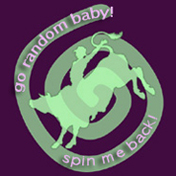Thu 27 May 2010
Scream Ratio
Posted by anaglyph under In The News, Movies, Oops!, Science, Silly, Sound
[18] Comments

Y’know, as much as I’m critical of the woo-mongers mixing it up with what they perceive to be ‘science’, I’m afraid that sometimes it’s the scientists themselves that need a good fresh mackerel to the side of the head.
Take this article Chaos Makes a Scream Sound Real, from ScienceNews.
To be fair, it’s not just the scientists. There’s a combination of factors that contribute to the diffuse, nutty quality of this piece, and it’s one that you find frequently in science journalism: a scientific concept that doesn’t immediately appear to be anything remotely worth reporting to a general audience, and a journalist’s desire (or job requirement) to try and spice it up into something that does.
I’ll try and paraphrase the whole idea for you, since I can’t be entirely sure what this is exactly about from reading either the Science News article or the abstract of the paper at Biology Letters, where it was published under the title Do film soundtracks contain nonlinear analogues to influence emotion? ((And I’m not about to fork out for the full article – people still aren’t getting this stuff. Listen to me Biology Letters editors: religious fundamentalists of all persuasions make their stuff available to all and sundry for nothing. THEY ARE YOUR COMPETITION! Get with the 21st Century already!))
Some scientists studying vertebrate communication observed that:
A variety of vertebrates produce nonlinear vocalizations when they are under duress. By their very nature, vocalizations containing nonlinearities may sound harsh and are somewhat unpredictable; observations that are consistent with them being particularly evocative to those hearing them.
What they’re basically saying is that jarring, loud or sudden sounds have a noticeable impression on an animal hearing them.
Yup.
They go on to hypothesize that maybe this is the case for humans too, and that filmmakers use that trick in films.
Yup.
To this end, they analyzed a bunch of films and found that there are more jarring and sudden sounds in horror films, although some appear in action films and a few appear in drama. ((Without even doing an experiment I can tell you that there would be close to none in comedies and romances.))
Yup.
Then they sum up their hypothesis with:
Together, our results suggest that film-makers manipulate sounds to create nonlinear analogues in order to manipulate our emotional responses.
(Translate that to: ‘Film-makers use different kinds of changing sounds for emotional effect’)
Er… Yup.
Now, I don’t suppose that this was likely to be an experiment that cost oodles of money, but whatever they spent on it was WAY too much, because they could simply have emailed me and I would have told them all that for free.
The Science News reporter makes a futile attempt to spin this up into something more than what I just told you, by stirring in some references to Chaos Theory (wtf?) and getting a quote about ‘crying babies’ from a cognitive biologist who was not even involved in the study (‘Screams are basically chaos!‘). She then tags the piece with an entirely irrelevant factoid about how Hitchcock’s The Birds contains sounds that were electronically generated ((I’m not even sure I understand what the point of including it is – that electronic sounds are more jarring/chaotic/annoying than natural sounds? Again, wtf? It’s not true, and it’s immaterial in this context anyway!)) and signs off with the following knowledgeable-sounding quip:
…capturing a realistic, blood-curdling cry is so difficult that filmmakers have used the very same one, now found on many websites, in more than 200 movies. Known as the Wilhelm scream it is named for the character who first unleashed it in the 1953 western The Charge at Feather River.
Well, someone has been pwned here and I’m not sure who. Either the reporter hasn’t done her homework, or she thinks that no-one will notice this risible flub. The Wilhelm scream is used in a lot of movies, not because of its terrifying blood-curdling quality, but because it’s so utterly lame that it has become a game among sound editors to see if they can sneak it in skillfully enough to let the director keep it in the final sound mix.
What’s more, it’s even extremely well known for that reason as even a very cursory search will reveal. Here’s a (VERY old) YouTube compilation of appearances of the Wilhelm scream.
You’ll have noticed that many of the above clips are from the George Lucas/Steven Spielberg stable, and that’s because sound design guru Ben Burtt is responsible for ‘resurrecting’ the Wilhelm scream in Star Wars and the fun challenge of trying to get it into mixes arose among sound editors who worked with Burtt (and with some of whom I’ve worked myself, so I know of what I speak).
I’m all for the concept of popularizing science, but this kind of writing doesn’t really help anyone. It’s painting a hazy and inaccurate picture for a lay audience, can easily be demonstrated to be factually sloppy and, worst of all in my book, because of the two preceding transgressions, casts a sickly glow over the effectiveness of all other science reporting. Science can’t, and shouldn’t be, reported in the same way as entertainment. Science is interesting for what it is, and if you’re a science reporter and can’t find an appropriately absorbing way of working with the actual facts at hand for a story, you should leave it alone and go on to something else. ((Another disappointing consequence of this phenomenon is that the bad story gets picked up, often completely uncritically, by other popular science outlets. In this case I note that it appears in Wired Science who should totally know better.))




Dang! Th 5 middle As there should be superscriptd!
Friggin HTML-escapin comments-boxski!
I fixed it fer ya.
It ‘sounds’ good to me!
AUUUGH!
I like th fackt that th original Wilhelm was a cowpoke.
Ach, du friggin Lieber!
It must be some kind of art that Malach practises every day, to be so successful in penning the most banal comment possible. I don’t think I could accomplish it even if I tried.
As far as Wilhelm’s fate is concerned, well, he asked for it – has he not read ‘The Bit-Part Player’s Guide to Staying Alive’? I think it’s right there in Chapter 1: ‘When in injun country’ don’t stop in plain sight for a smoke’ It’s just before ‘If playing a German in the trenches, don’t hand around a photo of your pretty sweetheart back home’.
If on the Starship Enterprise, don’t be the crew member we’ve never seen before seconded to the landing party.
It’s OK if you have a last name.
If the grizzled half of a mismatched pair of cops, don’t be one day from retirement.
Aparently, th Wilhelm Scream is among the many important things the white man taught th American Indian.
I wondr: Has anyone evr tryd sneaking th Wilhelm Scream into a sex scene?
It strikes me that the Wilhelm scream would find its way into a sex scene only in the event of something rather… untoward… taking place (for instance, I can imagine it appearing in a prison ‘sex scene’, if you get my drift…)
Joey Polanski’s text version nailed the scream for me. I was trying to remember what it was like, and that describes it perfectly.
I’d *love* to watch a porn and find the audio guy had found a way to mix that in… but yeah, it’d be a challenge.
Only part of your article I disagree with is “Science can’t, and shouldn’t be, reported in the same way as entertainment”. This is the kind of science snobbery that’s got us where we are, with science being seen as this remote, unknowable, ungraspable thing, rather than something that every person should be doing in their daily work and play.
To reach the public, a science article needs to be as accessible as an article on footballer unfaithfulness.
Neither science nor entertainment is always reported perfectly: but I’d far, FAR rather that science is reported imperfectly than that the reporter “leave it alone and go on to something else.”
There is a definite difference between researchers and entertainers: successful entertainers are good at selling themselves to the general public; successful researchers are good at selling their research to funding bodies.
The result of these different selection pressures is that in general researchers tend to be much worse at making their work appealing to the public.
So, researchers *need* science reporters to glam it up, to pierce through their pages of pretentious abstract waffle, jargon and complex formulae, and make it interesting to the common man in the street.
Sure, scientists (geeks of all flavours really) should get better at speaking to lay persons: I even feel that “speaking lay English” should be a required part of any specialised university course. But with their current selection pressures, they’ll never be as good at grasping the mind of the public as entertainers.
I’m working on trying to keep my comments short. It appears I’m failing.
To address your addendum first: we love long comments here on The Cow, keep ’em coming! There’s nothing better than an idea that sparks discussion. That’s half the point of what I do.
To address your criticism – I possibly should have made my point clearer. I don’t object to science being entertaining – but I stand by what I said: it shouldn’t be reported in the same way as entertainment. I completely agree with you that it needs to be accessible, and even ‘glammed up’ but the article I’ve looked at above is the best example I can imagine of how NOT to do that.
Let me elaborate: first of all (and perhaps worst of all) the writer completely fails to give the reader much of an idea of what the scientists in this study are actually doing. I’ve had a bit of fun with it, because reading through the Science News article gives one the impression that these dudes are just indulging in a piece of frippery – I’d be surprised if that was the case. Nevertheless, that’s the takeaway. It sounds like some scientists are on a bit of a junket to watch movies and make it look like work.
Secondly, the writer imposes some half-baked ideas on what she thinks is going on to give it some ‘pizazz’:
As near as I can tell from reading the abstract, ‘chaos’ (the mathematical kind) has nothing to do with this idea. The researchers use the term ‘non-linearity’ in a way that is meaningless unless the sound is contextually placed. Is it non-linear in frequency or non-linear in dynamics? Or non-linear in temporal placement? Or all of these things? Whatever it is, in general terms it can be very simply reduced to what I said in my post – sudden, jarring, loud. The term non-linear is gobbledigook without some point of reference. Maybe what they mean is explained better in the actual study. Whatever the case, the reporter tagging it with the term ‘chaos’ is not helpful. She may as well have said something equally as daft like ‘fractal’.
A third distraction is the grab-bag of quotes that Ehrenberg’s used to back up her story – none of them are actually particularly enlightening or apposite, and the one from James Wierzbicki about The Birds is, as I mentioned, completely irrelevant. What does it have to do with anything at all that the sounds in The Birds were electronically generated? If there’s a point to using this quote, it completely bypasses me.
Lastly, Ehrenberg uses a trite pop meme solely because it can be related to the words ‘scream’ and ‘movie’ – it otherwise has exactly NO relevance to this research. What’s worse, she attempts to MAKE it seem relevant by completely misrepresenting its provenance.*
Any of the above transgressions would be fine in reporting entertainment news – there is so much smoke and mirrors in that business that it goes with the territory. Who really cares if someone makes a flub and gets their facts wrong.
But (and I’m sorry it’s taken me so long to get to the actual point!) here’s the problem with reporting science in this manner. In this particular case I can see where all this silliness lies because it’s my field of expertise. If I’d been reading a story on, oh, say, climate change or swine flu I might not know if the reporter was pulling these kinds of stunts. This really bothers me. Unlike entertainment reporters, science reporters have power and responsibility.
Now, if it was the only way to get science out there to the masses, I might cut it some slack, but there are damn good science reporters out there who can manage to write an accurate story and make it entertaining. In my opinion, trashy writing like the ‘scream’ account just undermines all good science writing. You only need ONE person in the pseudoscience field to pick up on the fact that science reporting is a bit wobbly and you get an antivax movement.
So. Science reporting can be entertaining, by all means, but I think there’s no reason at all that it can’t also be reported accurately and responsibly.
(*She also pulls another journalistic stunt that I really hate – by conflating the quote by Tecumseh Fitch (A true, harsh scream “is not a trivial thing to do”) with the immediately-appended Wilhelm scream anecdote, she makes it appear that the Wilhelm scream idea comes out of Fitch’s mouth. If you don’t read punctuation, that’s what you’d think, and several people on the Wired Science site fell for it. That’s really third-rate journalism.)
I’ve also missed the point of the post.
I found it funny that … “it’s so utterly lame that it has become a game among sound editors to see if they can sneak it in skillfully enough to let the director keep it in the final sound mix”
I’ll assume two things …
1) the director shouldnt know that the sound editor is trying to put it in. Or if they are aware, then they believe that the audience wont notice.
2) anaglyph is too nice. if i’m going to do something, then I wouldnt do it for free if a stranger was willing to pay for it.
din
The game generally plays out that the editors sneak it in, and if the director doesn’t call you on it, it stays. Or, occasionally, the director gets the joke and lets you keep it. I’ve used it twice, and got called on it once – and it was pretty obviously inappropriate on that occasion. But we all laughed anyway. We do a lot of silly things that the audience isn’t privy to.
As far as getting paid for things goes, well, normally I’m expensive, but when it’s in the interests of good science my terms are flexible.